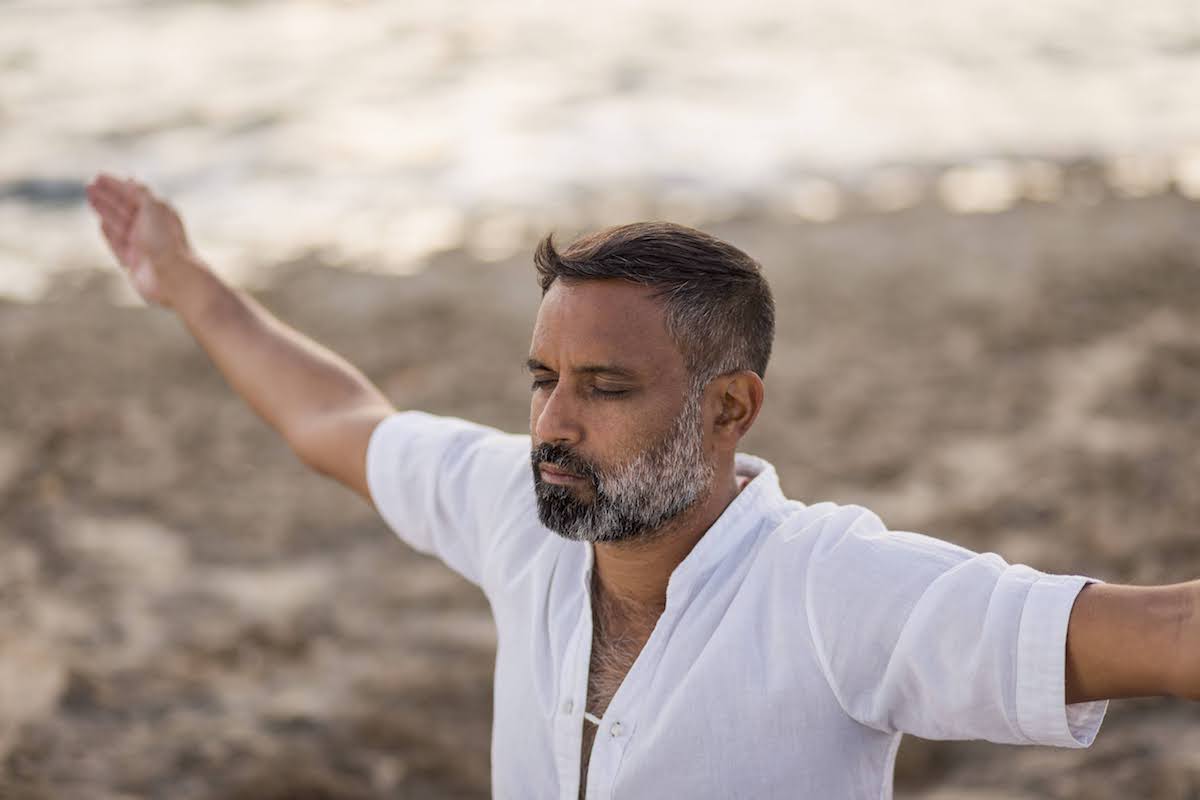Breathwork experts claim that you sleep the way you breathe. And if you want to rest better, breathing techniques for sleep can give you breathtaking results.
On top of that, you will enjoy a plethora of breathwork benefits, such as improving your mood, fortifying your immune system, lowering stress and anxiety, elevating your outlook on life, and increasing mental focus.
Most importantly, practicing these exercises doesn’t require special equipment or training. All you need is your bed and your breath.
According to Niraj Naik, the creator of SOMA Breath® and trainer of Mindvalley’s Breathwork for Life Quest, breathwork is like a pharmacy of different techniques. Not only can it improve your sleep, but it can also give you peace of mind and peak experiences.
The most common reasons for insomnia
How do you know you have insomnia? Here are the major symptoms of it:
- Finding it hard to go to sleep
- Waking up several times during the night or waking up early and cannot go back to sleep
- Feel tired and unrested after waking up
- Being unable to nap during the day even though you’re tired
- Feeling irritable during the day and finding it hard to concentrate during the day because you’re tired
Depending on how long you have these symptoms, there are two types of insomnia: short-term and long-term. Short-term insomnia is when you have it for less than three months. Insomnia that lasts three months or longer is defined as long-term insomnia.
The most common causes are:
- Stress, anxiety, or depression
- Noise
- A room that’s too hot or cold
- Uncomfortable beds
- Alcohol, caffeine, or nicotine
- Recreational drugs like cocaine or ecstasy
- Jet lag
- Shift work
There are also health conditions and medicines for these illnesses causing insomnia:
- Mental health conditions, such as schizophrenia or bipolar disorder
- Alzheimer’s disease or Parkinson’s disease
- Restless legs syndrome
- Overactive thyroid
- Menopause
On top of that, you can experience trouble sleeping due to:
- Chronic pain
- Sleepwalking
- Snoring or interrupted breathing while sleeping
- Suddenly falling asleep anywhere
- Nightmares or night terrors
- Dyspnea (shortness of breath)
The benefits of deep breathing before sleep
According to Niraj, the quality of your breathing has a tremendous impact on the quality of your sleep and vice versa. There is a science behind the perfect night’s sleep, and it’s intertwined with the art of breathing.
Melatonin is one of the most important hormones for getting a good night’s rest. It regulates your sleep with the circadian rhythm and is a powerful antioxidant.
You can’t get a good night’s sleep without melatonin, so you want to create a lifestyle that supports its production.
“Coherent rhythmic breathing improves the quality of your circadian rhythm,” Niraj explains.
A 2018 collection of studies has shown that slow, deep breathing techniques may be highly effective in initiating sleep and facilitating falling back asleep.
Although modern science doesn’t completely understand the relationship between the autonomic nervous system and sleep, it’s clear to scientists that the autonomic nervous system (ANS) is integral to sleep quality and duration.
So, how does breathing affect your ANS in a way that helps treat insomnia?
Slow and balanced breathing activates the parasympathetic nervous system (PNS), which is responsible for your ability to relax. So when you breathe deeply and rhythmically through your nose, it kickstarts your relaxation response which in turn helps you fall asleep and sleep longer.
In a 2014 study, scientists measured the heart rate variability of fourteen self-reported insomniacs by polysomnography. They found that insomniacs who practiced slow, paced breathing compared with spontaneous breathing had fewer awakenings, decreased awakening time during sleep, and increased sleep efficiency.

8 amazing breathing exercises before going to bed
The following seven simple breathing exercises help your body and mind relax as well as encourage you to sleep like a baby. Learning how to breathe better at night can make it easier with these techniques:
1. The 4-7-8 breathing method
This exercise is designed to activate your PNS by extending your exhalation compared to the duration of your inhales.
How to do it:
- Step 1: Sit with your back straight.
- Step 2: Close your mouth and inhale through your nose to a count of four.
- Step 3: Hold this breath and count to seven.
- Step 4: Exhale out through your mouth and count to eight.
- Step 5: Repeat three more times to complete the cycle for four breaths in total.
2. Diaphragmic breathing
Also called abdominal breathing, it is about deep breathing into the abdomen. This technique lowers your heart rate and blood pressure, reduces stress hormones, and activates the body’s relaxation response.
How to do it:
- Step 1: Sit or lie in a comfortable position with your eyes closed.
- Step 2: Place one hand on your chest and the other on your belly. As you breathe, the bottom hand should move, while the hand on your chest should stay still.
- Step 3: Inhale through your nose for about four seconds, feeling your abdomen expand.
- Step 4: Hold your breath for two seconds.
- Step 5: Exhale slowly through your mouth for about six seconds.
- Step 6: Repeat for 5-15 minutes.
3. Box breathing
Box breathing, or square breathing, is a deep breathing technique that can help clear your mind, calm your nervous system, and decrease stress in your body. Box breathing is often used as part of sleep meditation.
How to do it:
- Step 1: Sit or lie comfortably.
- Step 2: Breathe in, counting to four seconds, slowly filling your lungs with air.
- Step 3: Hold your breath for 4 seconds.
- Step 4: Slowly exhale through your mouth for 4 seconds.
- Step 5: Repeat steps one to three until you feel calm.
4. Alternate nostril breathing
This breathing technique is one type of Prāṇāyāma. It’s often used as a mindfulness and relaxation method to calm your body and mind.
How to do it:
- Step 1: Sit comfortably with your back straight.
- Step 2: Bring your right hand up to your nose and move your forefinger and middle finger out of the way, placing your thumb on your right nostril.
- Step 3: With your right nostril closed, inhale slowly and exhale fully through your left nostril.
- Step 4: Close your left nostril with your ring finger.
- Step 5: Breathe in slowly and exhale fully through your right nostril.
- Step 6: Release your ring finger and close your right nostril with your thumb again.
- Step 7: Breathe in fully and exhale fully from your left nostril.
- Step 8: Repeat for 5-10 minutes.
5. Kapalbhati breathing exercise
This is another Prāṇāyāma technique that detoxifies all the systems in your body and prepares you for a restful night.
How to do it:
- Step 1: Sit in a comfortable position with your spine straight. Place your hands on your knees, palms facing the sky, keeping your elbows straight.
- Step 2: Take a deep breath and focus on your exhale.
- Step 3: As you exhale, pull your stomach in and back towards the spine, feeling the abdominal muscles contract.
- Step 4: As you relax the navel and abdomen, your inhale happens automatically.
- Step 5: Take 20 such breaths to complete one round.
- Step 6: After completing the round, relax with your eyes closed and observe the sensations in your body.
- Step 7: Do two to three rounds.
6. Buteyko breathing
The main goal of this technique is to normalize your breathing. It’s based on three principles: nasal breathing, reduced breathing, and relaxation.
How to do it:
- Step 1: Sit comfortably and breathe through your nose naturally for about 30 seconds.
- Step 2: Take more intentional breaths in and out through your nose.
- Step 3: Gently close your nose with your thumb and forefinger, keep your mouth closed, and hold your breath as long as possible.
- Step 4: With your mouth closed, take a deep breath in and out through your nose again.
7. SOMA breathwork for better sleep
This breathing exercise is designed to help you sleep better by switching on the PNS. You will fall asleep much easier and feel refreshed and rejuvenated in the morning.
How to do it:
- Step 1: Sit comfortably with your back straight.
- Step 2: Inhale deeply through your nose or mouth.
- Step 3: Gently and slowly breathe out of your mouth as though breathing through a straw.
- Step 4: As you exhale, imagine a wave of relaxation flowing down your body from the top of your head to the soles of your feet and the tips of your toes.
- Step 5: Once you have exhaled, hold your breath for a few seconds before inhaling and inhaling deeply.
- Step 6: Repeat the process for 5-10 minutes.
8. Breathing control
If you suffer from dyspnea, learning how to sleep with shortness of breath can relieve an intense tightening in the chest, air hunger, difficulty breathing, breathlessness, or a feeling of suffocation.
Try this simple breathing control exercise.
How to do it:
- Step 1: Put one hand on your chest and the other on your stomach.
- Step 2: Close your eyes to help you relax and focus on your breathing.
- Step 3: Slowly breathe in through your nose with your mouth closed.
- Step 4: Gently breathe out through your nose.
- Step 5: Make your breaths slow, relaxed, and smooth.
- Step 6: Repeat the process until your breathing becomes effortlessly steady.
Other tips for better sleep
Let’s look at what you can do to improve your melatonin production:
- Dim your room to ensure you sleep in complete darkness.
- Eliminate blue light coming from artificial sources before you go to bed. Use candles instead of light.
- Minimize any activity before sleep.
- Go to bed before midnight.
- Ensure you have your last meal at least four hours before bed.
- Don’t drink any alcoholic beverages.
SOMA breathing for life
Niraj explains that if you have trouble sleeping at night, you don’t breathe correctly during the day.
Luckily, even if you don’t breathe properly when you’re awake, you can learn breathing techniques and incorporate them into your evening routine to improve your sleep quality.
And the magic of breathwork is that once you start practicing it, you can reach a state of total bliss and optimal health and well-being.
If you’re looking to heal, transform, or transcend, utilizing all the benefits of breathwork, join Mindvalley’s Breathwork for Life Quest with Niraj Naik. You can check out a sample class of the quest by registering at Mindvalley for free.
In just 14 days, you will master your breath with SOMA, the world’s leading breathwork methodology, and learn:
- SOMA breathing techniques for optimal digestion and nutrition and deep sleep
- How to use breathwork for spiritual awakening and reaching the peak human experience
- How to reverse aging through breathing and more
Welcome in.









